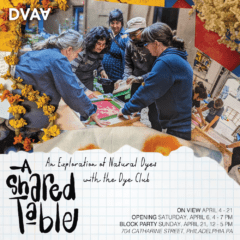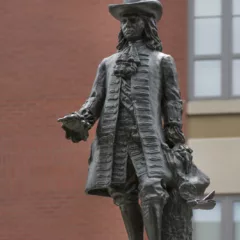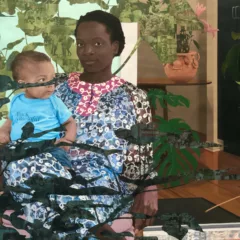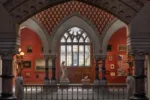The Pennsylvania Academy of the Fine Arts, in the past two years, has acquired work by five African American artists, four of them from the international and national art strataspheres. Their work looks spectacular in the show Summer Surprises, an exhibit that includes recent acquisitions of work by 11 artists, placing the 11 in the context of some earlier acquisitions also on display! The large contingent of artists of color working within yet challenging and stretching the academy’s reality-based tradition is the big news.
The five with work acquired in 2010 and 2009 are Mickalene Thomas, Kehinde Wiley, Mark Bradford, Odili Donald Odita and Clarence E. Morgan. Plus in 2008 PAFA acquired Jacob Lawrence’s Hiroshima series.
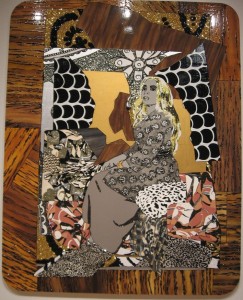
A huge Mickalene Thomas (New York) painting Din Avec la Main Dans le Miroir, which shows how a painting of a fully dressed woman can still be sexy, thereby turning the pale odalisque tradition upside down. The subsidiary dark-skinned attendant of Manet or Ingres is now the star. Thomas unites voluptuous fabrics and rhinestone glitter that burst with patterns that fracture and challenge the illusion of space. Her ability to redefine taste and beauty is as breathtaking as ever, here. And the figure although sexy is dignified.
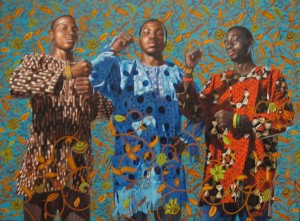
Nearby, New York artist Kehinde Wiley’s Three Wise Men Greeting Entry into Lagos shows three dewy young men in African prints, their poses based on a 1507 altarpiece of the Three Magi by Hans Baldung Grien. In Wiley’s painting, the background is a flat wallpaper pattern, which sometimes slips over the foreground figures, playing spatial games. Wiley’s insertion of dark-skinned faces–beautiful male figures–in art historical context using art historical techniques is equally subversive in terms of content, but not in terms of technique.
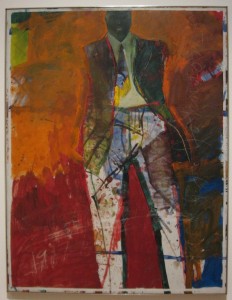
These two works seem all the more interesting to me in the context of an iconic portrait by Ray Saunders of Jack Johnson from 1971, also included in the exhibit. (Saunders, also African American, was a PAFA student 1953-57.) The bold colors, jazzy brush work, the enormous body, the head so high it is shrunken to suggest sharp perspective, the blackness of his skin and the simplified face all turn Johnson into a sort of deity. But Johnson is already a deity, a cultural hero, whereas the subjects of Wiley and Thomas are unknowns. This glorification of unknowns is mainstream contemporary practice and also bespeaks the shifting social stage all around us where dark skin has claimed visibility and our president is also a man of color.
With these works, PAFA curators Julien Robson and Robert Cozzolino are chronicling the contemporary reimagination of portraiture, power, beauty and sexuality, with artists painting dark skin on a huge scale into the Western canon. Thomas takes this a step further, re-imagining the nature of painting itself. For these works alone the exhibit is worth visiting.
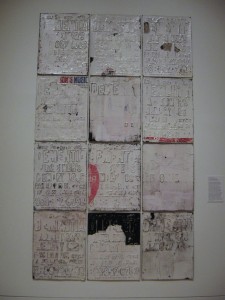
And speaking of reimagination of painting and printing, L.A. artist Mark Bradford’s Untitled (Dementia) looks like a grid of metal press street signs. The signs however are made from posters advertising services for dementia sufferers–the words fading into layers of lost meanings. This work was part of Philagrafika’s Graphic Unconsciousness exhibit at PAFA and I’m happy to see it again.
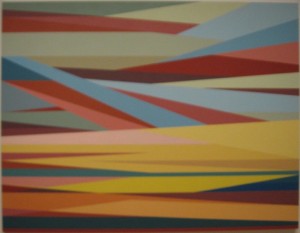
African-born Odili Donald Odita’s 2010 painting Future Perfect is such an anti-painting of an idyllic landscape, it bears consideration for how it refuses to deal with texture or the artist’s hand a la Sol LeWitt. The colors are smashing, and I find myself thinking once again about design and decor as critical elements influencing painting at this point in time. Odita is now in Philadelphia.
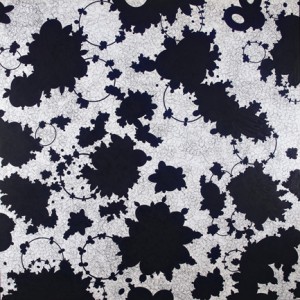
The fifth of the group, Clarence Morgan (Minneapolis) was a PAFA student in the ’70s. His black and white bubbling vortex plays figure-ground games with the eye and games about microscopic life forms and fractals. I suppose they can be interpreted as having racial content—-but if there’s political content here, it’s heavily encoded and deracinated. (But then the same arguably goes for Bradford and Odita.)
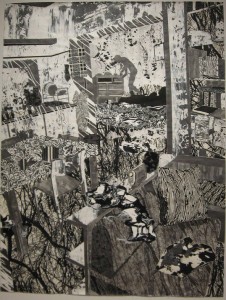
I don’t mean to give the impression that the show is wholly work by African-American artists. But they do take over. In the context of Thomas’ and Wiley’s use of pattern, a large drawing by recent PAFA MFA Doron Langberg (Israel) seems especially apt. In Langberg’s Looking for the Lube, an elaborate apartment scene is disrupted by a frantic, aroused man, and by the turmoil of domestic decorative patterns. There’s none of either Thomas’ or Wiley’s iconographic flatness and all-out color and portraiture, but Langberg has a subtext of sexual identity as do the other two. He also owes a lot to magazines like Architecture. His figure is in silhouette and for all the sexiness, he’s a cipher in a layered, theatrical space. This work is not about skin.
Other recently acquisitions in the show are from: Tom LaDuke (Californian), acquired 2010; Nancy Spero, acquired 2010; Jules Kirschenbaum, acquired 2010; and Dorothea Tanning, acquired 2010. I loved the conversation between 2010 LaDuke and the 1950s Tanning. But all of these works are worth a nice long look.
The Vogel Collection
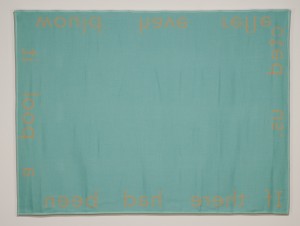
Also at PAFA is a selection of art collected by a postal worker and librarian. The extraordinary collection of Herbert and Dorothy Vogel is represented here by 50 works, art that ranges from polar opposites Lynda Benglis to Richard Tuttle. Need I say more????
Well, yes, I do. I need to say that if you haven’t seen Herb and Dorothy, the video about them, this is an opportunity (it’s 87 minutes). It’s looping in the lobby. And just like Herb and Dorothy prove you don’t have to be Rockefeller to collect art, you don’t have to be Rockefeller to see the video–if you go to PAFA now.
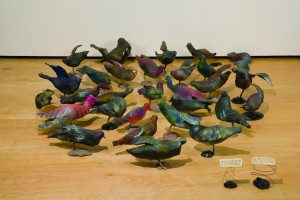
The exhibit itself, The Dorothy and Herbert Vogel Collection: Fifty Works for Fifty States, is part of a project by the National Gallery and the Vogels to give 2,500 works from their collection of 4,000 objects to 50 museums in 50 states, and PAFA is the lucky museum in Pennsylvania. The show is of the 50 pieces PAFA received, many of them wonderful. Among my many faves are a juicy little painted object by Don Hazlitt and Cheryl Rupp’s Pigeon Flock with Rats. I suppose some may be appalled by this institutionalization of the private, but this action is preserving the art and giving the public access to it.
Reminders about other stuff at PAFA
Roberta told you about the Warhol prints and polaroids Wednesday, and Andrea told you about Roxana Perez-Mendez’ Este Es Mi Pais video installation . And if you’re a Jasper Johns fan you can get up close to one of his flag paintings.
Vogel, Summer Surprises, Warhol and Johns, all in the new Hamilton Building, run through Sept. 12.
Perez-Mendez, in the original building’s Morris Gallery, runs through Sept. 25.



